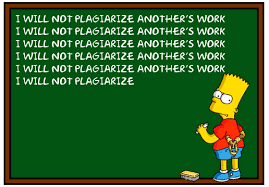Plagiarism has likely been a dilemma in education since the
dawn of time. One could argue that prior to the digital age, it would have been
easier for students to plagiarize that it is these day, because what teacher
had the time to go and scroll through slides of microfisch, or dig through
dusty magazines in the bowels of a library? In Chapter 8, Hicks points out that
the changes in the way students conduct research in the 21st century
can have both significant benefits as well as complications. I agree with him
in that regard. Owing to the digital age, students can “look at SparkNotes
about the text, and find essays about the text from online paper mills” (Hicks,
p. 155).
In my opinion, having instant access to an unfathomable
amount of information is beneficial to students 90% of the time. I’ll get to
that other 10% in a minute. In the “Open up the Ceiling on the Common Core
State Standards” article, Sally Valentino Drew points out numerous benefits to
online reading, such as the fact that “research demonstrates that struggling
adolescent readers are motivated by digital reading environments, as opposed to
the print-centric reading environments,” and that “online and other digital
environments may allow struggling readers to break free.”
That makes all the sense in the world to me. Research can be
daunting on its own without having to find actual, physical texts to support
one’s claim. Almost anyone would agree that all of the information that lies a
thumb stroke away is a positive thing.
Where we run into trouble is when students don’t synthesize
what they read and state information in their own words. There are so many
sources out there, that I honestly believe some students end up plagiarizing
without meaning to. I’m all for reading an essay as a model or mentor text, but
if a students reads twenty sample essays on how to compare and contrast Alice
Walker and Maya Angelou, I can almost guarantee their final product won’t have
one original thought. Or if we ask a student to take part in a discussion of
themes in The Great Gatsby, five
minutes spent on SparkNotes will ruin whatever discovery might have happened in
the midst of their group of peers. There is no way to prevent students from
seeking support through those sources, however, and some students who really
struggle can benefit greatly from the extra scaffolding.
Where I disagree with Hicks is in his strong feelings
against anti-plagiarism software. Hicks believes that using such devices “puts
students in a defensive position and is likely to harm relationships.”
Furthermore, he recommends using digital tools like “Easy Bib to defend against
plagiarism” (p.158-159). I honestly don’t see how Easy Bib steers students away
from plagiarizing. They still must enter the information, but where Easy Bib is
problematic is that it can mess up spacing on students’ works cited page.
Instead of teaching them how to use sources like Owl Purdue to create their own
works cited page, we’re supposed to encourage using a crutch? My biggest issue,
however, is in Hicks’ encouragement to not use anti-plagiarism software. I do
see where he’s coming from in regards to eroding trust, but that is only if a
teacher uses this software sporadically, such as when he/she is suspicious
about a student’s writing. However, if the entire department or school uses the
software every time there is a writing assignment, it becomes just another part
of the routine for the student.
Unfortunately, I’ve had too much personal experience with
this very topic in the last few months. Because I’m subbing for a teacher who
is on maternity leave, I wasn’t used to Turnitin.com, and thought it was for
only summative assignments. I didn’t tell my American Lit class to use it for
their compare and contrast essays, and TWO of the students cheated. One
submitted an essay that was 94% identical to a college student’s in Virginia.
Turnitin.com provided the exact source, so it wasn’t difficult to confront the
student. The other one plagiarized almost word for word from his peer in the
same class – something I caught because I was paying attention, but
Turnitin.com checks for that type of plagiarism, too. Our school’s policy is
that students must have a 5% or below on Turnitin.com before they can even
submit their work to teachers. The temptation to plagiarize is a non-issue, and
students are ultra-diligent about thoughtful paraphrasing so they stay under
the 5% marker. It teaches good habits and promotes honest writing.
 |
| Credit: Avatargeneration.com |
